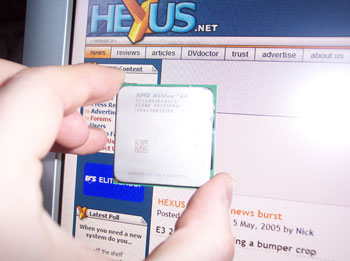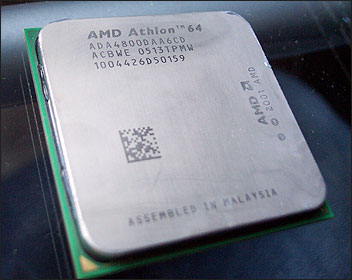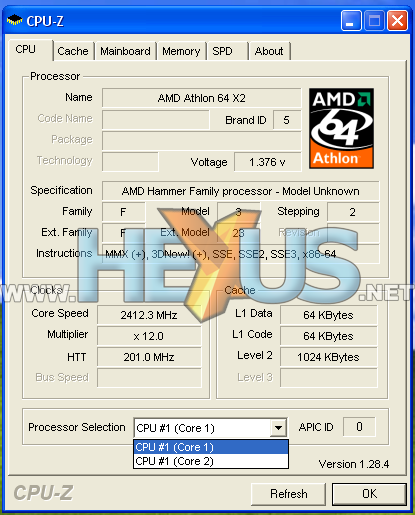HEXUS.afterburner :: Paul Dutton's take
HEXUS first published its review of the AMD Athlon 64 FX-51 way back on the 23rd September 2003.More than a year and half later, with each successive release of faster models of Athlon 64 FX processors, AMD have simply ruled the roost as the ultimate processor for PC enthusiasts and gamers.
Out of the box, no matter how much money you've had to spend, overall there's simply been nothing faster than AMD's flagship desktop processor.
Indeed at times, and particularly with the introduction of processors based upon its much heralded 'Prescott' core, it looked as though Intel was going backwards with its Pentium 4 processors. Sometimes slower, hotter, noisier and more expensive than it's older 'Northwood' core variant, the last time HEXUS Group Technical Editor Ryszard Sommefeldt, looked at the Intel Pentium 4 Extreme Edition, we damningly concluded “The Extreme Edition CPUs remain a pointless exercise for Intel.”
So it was almost with a sigh of relief, when earlier this month, on the 4th April, we published the first hands-on look at the dual-core Intel Pentium Extreme Edition 840. Intel looked as though it was back in the game and, it appeared, fairly convincingly so.
Finally - a high-end desktop processor from Intel which not only captured the imagination of PC enthusiasts, but also with its unlocked multipliers, would appeal to overclockers.
And viewed in the correct context, its out-of-the-box performance seemed competitive too.
Intel is also to be commended on being the first manufacturer to sample HEXUS with a dual-core processor for the consumer desktop.
Surely it's what all the Intel Pentium 4 Extreme Edition processors should have been from the outset?
But today, only some fourteen days later, with this, our exclusive hands-on look at the AMD Athlon 64 X2 Dual-Core processor, our initial enthusiasm for Intel's delivery of the Pentium Extreme Edition 840 is somewhat diminished.
From everything that we've seen of the AMD Athlon 64 X2 Dual-Core processor so far, it's faster – much faster – and for a processor that's almost certainly not going to come in at a bargain-bucket price, the promise of compatibility of A64 X2 Dual-Core with all existing Socket 939 mainboards which already support its Athlon 64 FX53 and FX55, also make it an easy and relatively inexpensive upgrade for existing AMD customers.
Which is not so for existing Intel customers. An Intel PC owner who might be tempted to upgrade to dual- core technology, will require a new high-end DDR-2 mainboard featuring Intel i955X Express core logic.
Might an existing Intel customer, wanting the benefits of dual-core processing, not consider the option of retaining his investment in his DDR-1 system RAM by moving to AMD Athlon 64 X2 Dual-Core because he's forced to purchase a new mainboard anyway?
It seems that little AMD have scuppered the mighty Intel again, especially so when you consider it's effectively bent them over with Athlon 64 X2 identifying itself as a supporting Hyper-Threading.
All Intel's work in evangelising Hyper-Threading to Independent Software Vendors (ISVs) will simply bear greater benefit to AMD Dual-Core customers, and at zero cost to AMD.
What utterly escapes us is why Intel, with so many of its customers operating in areas where they would potentially benefit from a truly efficient multi-processor implementation, who have been developing dual and multi-processor systems for decades, and with all its financial resources, simply hasn't moved to an architecture where each processor has its own dedicated path to system RAM via an on-die memory controller.
Are we missing something? Is it the case that AMD UK have managed to 'message' HEXUS better than Intel UK? Absolutely not. HEXUS maintains an excellent relationship, outstanding even, with Nick Knupffer, Intel UK's hard working Public Relations guy. Nick does a sterling job and is constantly communicating with HEXUS, and assisted by Kate Hayward at its PR Agency Catalysis Communications, HEXUS is provided, mostly proactively, with access to most everything we need to see Intel's view of the world.
During the course of the past year or so, Intel’s proactivity has been a direct contrast to our relationship with AMD UK's PR Office, and although we’ve recently been assured that matters will improve, the lack of empathy we’ve received to our requests for product samples, has even lead to our having to address ignorant comments made by one reader here who seems to be implying we're biased to Intel.
No – the bottom line is that this is as it should be - an objective judgement on the merits of the technology and its positioning. The HEXUS readership expects and deserves nothing less, and that's precisely what HEXUS delivers you.
All the signs are that AMD Athlon 64 X2 Dual-Core is where it's at for the consumer desktop, and with the impending release of this and Dual-Core AMD Opteron server and workstation products, our take is that if businesses have to pay for the technology it uses, and without any subsidy, then Intel's going to be significantly losing market share in its most important stronghold.
Hewlett Packard's recent adoption of AMD Opteron for high-performance NVIDIA SLI workstations and a whole range of SME and enterprise servers, was probably the most significant design win, and endorsement for AMD yet. Furthermore the news we broke on Friday about a SuperMicro involvement with AMD Opteron products via its - previously Intel exclusive - distributor Boston Limited, simply reinforces our viewpoint that Intel's lucrative stranglehold in the business computing sector is loosening.
And AMD Turion 64 – its 64-bit mobile processor notebooks is another part of the jigsaw. Aside from competitive performance at all levels, Turion 64 gives notebook manufacturers a far greater freedom of components choice when creating their skews. Intel Centrino works, and is a deserved success, but the platform essentially ties a notebook manufacturer to an Intel chipset and an Intel network controller. To be commercially competitive notebook manufacturers need to differentiate their products, and the AMD Turion 64 platform seems to give them that opportunity.
Exclusively speaking to HEXUS, Rahul Sood, President & CTO of specialist and luxury entertainment systems builder Voodoo PC told us: "AMD Turion 64 is the shiznit, and only the best ODMs have jumped on board with this technology. By the time the others figure out what just happened, AMD will be kicking ass and taking names. I would suggest that more ODMs give this 25 watt part another look, because bigger isn’t necessarily better – and this is coming from someone who understands what it takes to build a high performance notebook from scratch."
The world's going 64-bit, it's going mainstream multiprocessing, and AMD is firmly in pole position.
Our first hands-on experience of AMD Athlon 64 X2 Dual-Core simply hammers that home.
















